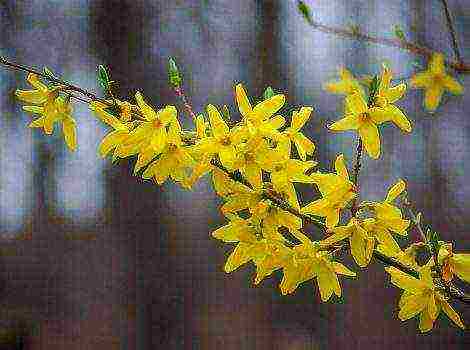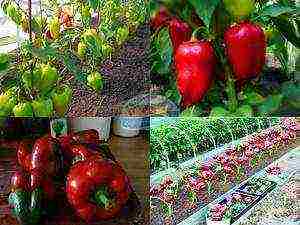Content
- 1 Common types and varieties of statice with photos
- 2 Growing methods
- 3 Landing in open ground
- 4 The subtleties of plant care
- 5 Cutting and drying statice
- 6 Pests and diseases and how to deal with them
- 7 Combination with other plants in the garden
- 8 Pedigree statice
- 9 Benefits of statice as a garden plant
- 10 Growing statice
- 11 Sowing seeds statice for seedlings
- 12 Direct sowing in the ground
- 13 How else can you multiply statice
- 14 The right time and soil
- 15 Seed preparation and sowing
- 16 Landing in open ground
- 17 Caring for flowers on the site
- 18 Cutting and drying the immortelle
- 19 And a little about secrets ...
Statice has become widespread among flower growers not so long ago, but has already gained great popularity. The second name of the flower is limonium or kermek. Belongs to the Pig family.
It is currently widespread in various countries, but the homeland of this flower is Central Asia. It is also found in Europe, in Siberia, and even in Australia in arid zones or on the sea coasts. That is why the statice can be attributed to drought-resistant xerophytic plants that tolerate a lack of moisture well.
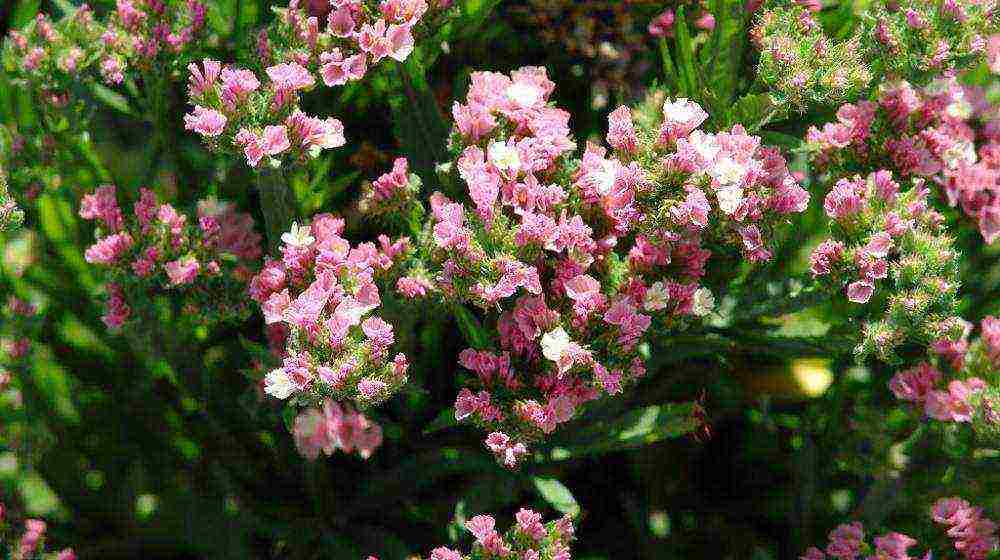
Statice has annual and perennial species. The plants are mostly herbaceous, but there are also dwarf shrubs. The roots of the statice are well branched, pivotal, the leaves are large, collected in a basal rosette. The stem is tall, erect, without leaves. The inflorescence is a panicle. Flowers are very small, up to 1 cm in diameter, with bell-shaped sepals.
The sepals are very interesting in the flower. They are tough, painted in different colors. It is they who give the statice a decorative look. The stomata of plants have the ability to close and thereby retain moisture when unfavorable, arid conditions occur.
Common types and varieties of statice with photos
There are more than 300 types of statice, about 40 are used in culture. The following types are most common:
- Statice Caspian - perennial plant. Height up to 50 cm. In natural conditions, it grows on the sea coast, salt lakes. The stems of this species have numerous branches, which gives the plant a special charm. Lilac flowers. Widespread in Europe, used for arranging bouquets. It is not winter-hardy in the middle zone.
- Statice Notched - an annual plant up to 60 cm high. The sepals are white, pink, blue with a purple tint. The leaf is dark green, wavy. Flowers are small, white.
- Statice Tree - subshrub up to 120 cm with pink flowers. It is not winter-hardy in the middle zone.
- Statice Bunge - an annual plant up to 60 cm. Flowers of violet color.
- Bonduelle statice - perennial plant up to 90 cm tall with yellow flowers. In the conditions of the Middle Lane, it is grown as an annual plant
- Statice Chinese - a perennial plant with yellow openwork inflorescences, grown in the Central lane as an annual.
- Statice Gmelin - a perennial plant up to 60 cm high. Grows in Siberia, Central Asia, Mongolia, Northern China, the Urals, Europe, found on the sea coast, in river beds. It blooms with lilac, sometimes white flowers. In the conditions of the Middle Belt, it hibernates with light shelter for the winter.

Blooming statice
Growing methods
Growing a perennial statice from seeds has its own characteristics. The planting material must be fresh, otherwise it may not sprout at all.
Before planting, for quick germination, you can sparge the seeds. For this, an aquarium compressor is used.
- Add a tablet of microelements or a few drops of Epin's solution to a liter jar of water.
- Place the seeds in a cloth and tie them tightly.
- We put the bag of seeds in a jar of water and turn on the compressor.
Within 12 hours, we process the seeds with air bubbles from a working compressor. After this procedure, seed germination increases.

Statice can be grown through seedlings
Growing a perennial statice from seeds at home is impractical. But if such a need arises, then the landing pattern will be as follows:
- You need to sow seeds in late April - early May. Before germination, keep the planting container in a warm place with a temperature of +20 degrees. When seedlings appear, the container with seeds is transferred to a colder room. For example, in an unheated greenhouse.
- At night, seedlings are covered with a film. It is taken into account that the seedlings of perennial statice have a taproot and do not tolerate transplanting well, therefore we place each seed in a separate container.
- At the end of May, the grown seedlings are planted in open ground, carefully transferring the young plant into the planting hole, previously watered with water.
We carry out growing seedlings of an annual statice from seeds at an early date. Growing a flower with seedlings is necessary in order to get the earliest flowering.
It should be borne in mind that the statice is growing rapidly and it is important to prevent it from stretching. Overgrown seedlings are more difficult to plant, they take a long time to take root.To avoid problems, it is necessary to plant seeds not earlier than the end of March.
It is important to know that the statice does not tolerate a pick and it is better to immediately plant it in seedling cassettes or separate cups with good drainage holes.
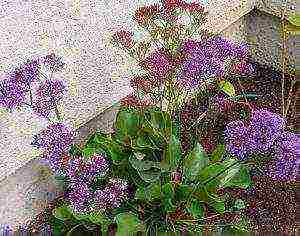
Statice does not need fertile soil
The soil is prepared from a mixture of sand and ready-made peat substrate, which can be bought at the store, in a 1: 1 ratio. Do not use humus or compost, but you can add a little vermicompost (commercially available). Vermicompost is added at the rate of 0.5 kg per 10 kg of the mixture... Remember that statice does not need soils rich in organic matter.
The depth of planting seeds in the soil is approximately equal to its two heights. For sowing, you need to make a small groove or just press the seed with your finger to the ground, pressing it a little, and sprinkle it with yellow river sand on top. The soil must be well moistened before sowing. Water the seedlings as needed, avoiding waterlogging.
Until the moment of germination, the temperature is maintained at +20 degrees, after the emergence of shoots, it is reduced to +15 degrees.
For the prevention of diseases, it is good to use the drug Previkur according to the instructions. With this tool, we shed the soil before sowing seeds and, if a disease is suspected, we also apply it to the seedlings according to the instructions.
If the seedlings grow poorly, watering is carried out with Fertika - a complex fertilizer with microelements: 1 gram of the drug per 1 liter of water.
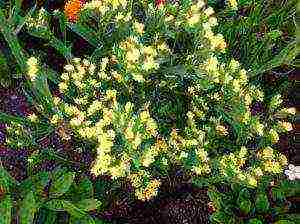
Plants need hardening before planting.
If the plants are elongated, retardants (growth retardants) are used, for example, Athlete. At the final stage of cultivation, Zircon can be used to accelerate flowering. Before planting seedlings in open ground, they are hardened by exposing them for a day from the greenhouse.
Seedlings are planted when the threat of night frosts has passed. Before planting, the statice can be treated with Epin for better survival and relieving transplant stress. When to plant seedlings in open ground, the weather will tell you.
Landing in open ground
Planting and care in the open field is not difficult. The main thing to remember is that the statice is a very light-loving and drought-resistant plant.
For planting the plants, they choose sunny areas with sandy permeable soil. In areas with heavy loamy soil, it is a good idea to add some sand when digging. Seedlings are planted at a distance of at least 25-30 cm. After planting, the plants are shed well.
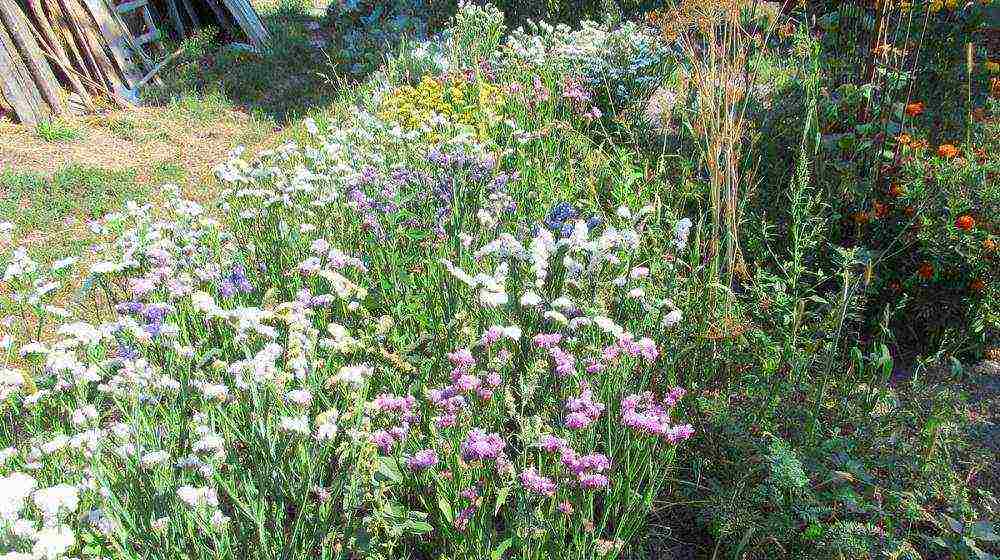
It is advisable to plant a statice in well-lit areas.
The subtleties of plant care
Watering for the statice should be small, but, nevertheless, it is necessary in hot weather. Slightly withered rosette leaves serve as a signal for watering.
For lush and abundant flowering, fertilizing is necessary at intervals of two weeks. It is better to use Fertik's complex fertilizer or liquid fertilizers based on humic acids. The use of organic matter is not desirable.
Since the statice is grown for dry bouquets, it is important to emphasize the beauty and brightness of its flowers. To do this, during the budding period before the beginning of flowering, spraying with a solution of microelements Cytovit is applied 1-2 times. After these treatments, the color of the flowers is brighter, richer.
Cutting and drying statice
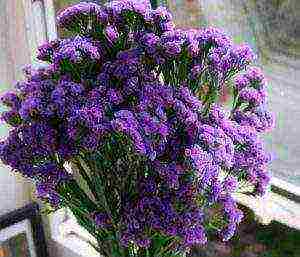
Statice looks great in bouquets
During the period of complete dissolution of flowers, they are cut, tied 5 pieces in bunches and hung on a stretched rope with a paper clip. The bouquet should hang upside down, so it will then look better in a vase. The drying room should be shaded so that the color of the flowers does not fade, and well ventilated. Drying of flowers takes 30 days. Statice flowers are also used to arrange bouquets.
Pests and diseases and how to deal with them
The statice is quite resistant to diseases and pests. Diseases can occur in cold and humid weather, as well as thickened plantings.
- Various rots appear as spots on the leaves. Control measures consist in the use of copper-containing drugs at the first signs of the disease.
- Fusarium and bacterial wilting. The plant is stunted. The tops of the leaves turn red, then turn brown and rot. The tops of the plants dry up. The stem turns black. There are no measures to combat, diseased plants are removed.
- Bacterial spotting. It appears as spots on the leaves. Copper-containing drugs are used, which are effective if the disease is in the initial stage of development.
Of the pests, leaf nematodes are rarely found. It manifests itself in the form of yellow, subsequently turning brown spots. Spreads with watering. Apply treatment with Aktara systemic insecticide. Watering is carried out with a solution of the drug under the root of the plant according to the instructions.
Combination with other plants in the garden
Statice looks great both in single plantings and mixed in the background. In the foreground of the bed (ridge length), you can plant bright low gatsania, which are also drought-resistant and require minimal watering.
You can get acquainted with the features of planting and growing statice from seeds from the proposed video. Happy viewing!
The international botanical name is Limonium sinuatum. Encyclopedic - hard-to-pronounce notched kermek. Folk - statice (according to the Latin synonym for the name Statice sinuata. Under the names statice, limonium or sea lavender, this interesting ornamental flowering plant is most often grown.
Statice: planting and leaving
Pedigree statice
A plant from the genus of the Pig family, which includes 350 species of herbaceous and lignified shrubs and flowers, scattered throughout Eurasia. "Relatives" of the statice can be found both in the Mediterranean and in Central Asia (in its coastal regions). There they form lush thickets with a height of more than half a meter. Sand dunes are also a very suitable habitat for the statice family. Thanks to the long root-rod, plants can easily stay in any soil, even the most loose one, and extract moisture from its depths.
Salinity of soils for statice is also not a problem - the plant feels great in the area closest to the Mediterranean Sea, in the coastal strip.
Kermek (Limonium)
Benefits of statice as a garden plant
It is beautiful with lavender beauty and unpretentious, like a weed.The popularity of the statice is growing every day, since flower growers discovered that this plant has many advantages.
- The plant is perennial, powerful, "unkillable". Pests do not attack it, diseases of other flowering plants do not stick to it. The only harm can be caused to the statice by the owner himself, filling the roots and causing root rot, from which the plant dies.
- Can withstand various climatic conditions. In nature, it grows in deserts with a chronic lack of moisture, and even manages to bloom magnificently.
Statice purple
- Doesn't take long to leave. It grows almost independently, growing every year and capturing an ever larger area.
- The soils are very different. Stitice will grow even on the most scanty soil, without fertilization.
- He dislikes only two things - stagnant water and darkness. Plant a statice in a sunny spot with drained soil and the plant will thank you for many years with colorful flowers.
- In landscape design, it can be used widely, since it has a variety of colors. Yellow, lilac, blue, white, pink, purple - these are not all statice colors that can be successfully combined with greens or other flowering plants in the garden.
Kermek, limonium or statice
- Statice has a very long flowering period. And the fringed panicles-inflorescences are excellent in cutting, therefore the flower is widely used in floristry to create bouquets and compositions.
Growing statice
Limonium
In order for this wonderful plant to bloom without special care in your garden, it must first be grown. The hassle of growing a lush bush from a seed will pay off handsomely. But first, this seed must be sown and looked after a little.
Growing conditions
Purple limonium
- Sunny places, windy areas are possible (sometimes there are strong winds on the sea coast).
- Sandy soils, limestones with a crumbly structure, with good moisture circulation and air penetration.
- For pot (tub) cultivation, the soil mixture is as follows: sand, algal limestone, garden soil - just one part.
- Watering an adult plant is abundant, but very rare. There is enough rain on open soil. In a drought - a maximum of twice a season.
- The statice will feel best in a rock garden, rockery or on a terrace in a tub filled with a substrate corresponding to the needs of the plant.
By the way! Statice can be grown on a sunny balcony, on a terrace, in pots, floor vases, tubs. It will grow even where no other plant survives.
Kermek Tatar
About water regime
Statice, regular watering is needed only when the plant is in the initial phase of growth - from sowing a seed to a seedling moved into the ground. But even at this time, watering the sprouts must be extremely careful. Improper watering is almost the only care mistake that can kill the plant.
- Do not water the statice if sunlight falls on the plant at this moment.
- You cannot water from above, along the leaves, always only at the root.
- Watering is contraindicated if, when lowering a wooden stick of a finger into a pot of soil 5 cm, soil remains on it.
- A signal about a lack of moisture is sagging leaves of the statice.
About dressings
Growing statice
The grower does not burden the statice with frequent fertilizing. Free-standing marine lavender in garden soil, a one-time application of long-acting fertilizer in the spring is sufficient. Dosage - according to the instructions. The next introduction is next year. If you are planting seedlings of this year, you can add a prolonged top dressing for planting and repeat once after two months.
Starting from September, fertilization of the garden plantings of the statice is stopped to allow the plant to prepare for wintering.
By the way! With any growing method, organic matter can be applied in the form of garden compost, but not more often than once a season.
If the statice grows in a pot, fertilize the plant with a complex of minerals monthly for.
About wintering
Here, in general, flower growers who grow statice in the garden have nothing to worry about. The Mediterranean "lavender", surprisingly, calmly withstands frosts down to -30 ° C. Of course, it needs to be prepared for wintering. As with any plants hibernating in the open field, the stems with leaves must be cut off in the statice. But if 20-25 centimeters of stems are left in roses, hydrangeas and other shrubs, the statice is cut off completely, to the ground.
Shelter flowers for the winter
Then the cut bushes are covered with straw, leaves, needles or brushwood. A non-woven covering material can be placed on top. This is insurance not against frost, but against excess water in the spring, after the snow has melted. It is not necessary to throw snow on the places of shelter statice. On the contrary, as soon as the snow cover begins to melt, it, together with the covering material, must be removed. This will prevent excess moisture from entering and root entanglement.
Flowers covered with spruce branches - photo
With a plant that stands on an open, unheated balcony in winter, it is even easier. All winter it remains on this balcony, wrapped in foil or burlap. The main thing is that the roots of the statice do not freeze in the tub. The rest will grow back in the spring.
Statitsa (Kermek) on the balcony
Sowing seeds statice for seedlings
If you, while relaxing on the seaside, decide to collect seeds for sowing statice in your garden, you need to do this in the middle of summer. It was at this time that the plant forms fruits, each of which contains one rather large dark seed. The collected seeds are placed in an airtight container and kept dry until spring.
Statice seeds
Seed statice today can be easily found in flower shops or ordered by mail. Breeders have come to grips with sea lavender not so long ago, but the results are impressive - more than 35 varieties have already been bred for garden and indoor cultivation.
Seeds of different varieties
Statice seeds are very small
Sowing seeds can start at the end of March and continue until mid-April. Traditionally, the pots or containers and the substrate are prepared first. The statice dives normally, so you can immediately sow seeds in rows in a large box or container. The main thing is that the soil in it is sandy, drained, not heavy.
For insurance, both seedling containers and soil are recommended to be disinfected. The easiest way to do this is by preparing an intensely colored solution of potassium permanganate with hot water. Spill the soil in a colander with the solution and rinse the previously washed boxes.
We prepare containers and disinfect the soil
Seeds from bags do not need to be processed. It is enough to soak them for several hours in warm clean water, then sow them into moist soil. Collected with your own hands - it is advisable to soak first, and then disinfect with potassium permanganate.
- Water the soil in the container abundantly. Wait until the water is absorbed and the excess flows out of the drain holes.
- Spread the seeds in even rows over the surface, without deepening.
Seeds are sown along the grooves
- Sprinkle the crops with fine-grained sand. Moisturize.
We moisten crops
- Place boxes in conditions: humidity - 60%, temperature + 18 ° С. Under these conditions, the emergence of seedlings will occur in one and a half to two weeks.
- While waiting for sprouts, the surface of the box must not be overdried, regularly sprinkling with water.
We are waiting for germination
A pick can be carried out early, after the appearance of the first main leaves. They dive into personal small containers of 3 seedlings. The soil for further growing seedlings is peat mixed in half with sand. A month later - the second pick - one seedling per pot to simplify the process of planting on a flower bed.
Seedling picking
Video - Sowing seeds of Kermek notched (Limonium, statice)
Landing in the garden
Mid-May is the time of planting young seedlings of statice in flower beds and flower beds.Open ground, even with return frosts on the soil, does not pose a serious threat to persistent limonium.
Kermek large-leaved
First, the soil in the flowerbed must be dug up and loosened well. You can add a loose component (sand), limescale. If possible, arrange a drainage system.
All weeds are removed from the flower bed - the grown limonium will "clog" weeds of any size, but tender seedlings do not yet have enough strength to fight serious wild competitors.
- Carefully remove the seedling from the pot together with the lump completely, trying not to destroy it.
Cooking holes
We take out a plant with a clod of earth
- We lower the lump into a basin prepared in advance with warm water for half an hour.
- We dig a hole to the depth of the planting scoop. Pour some gravel at the bottom. We put in the prolonged fertilizer. Sprinkle with sand.
- We mix the earth that remained after digging the hole in a separate large container with sand and dolomite flour. It will be used to backfill the plant when planting.
- We arrange a plant with a soaked lump in the planting hole, align the stem vertically, fill it with the prepared mixture.
Landing in the ground
- Water the plantings thoroughly.
Do not flood the flower, but make sure the ground is moist.
Video - Kermek broadleaf-Limonium platyphyllum
Planting in pots
Statice is rarely grown in indoor culture, but it is a frequent visitor on the balcony or terrace. The plant looks great in large floor pots. It is best to use earthenware containers. The clay is porous in structure, aeration of the roots of the plant is guaranteed.
In the pots, be sure to make large drainage holes and put a solid layer of shards, expanded clay or gravel.
The container on top of the drainage layer is filled with a quarter of the substrate. This is followed by prolonged fertilization, dusting with a thin layer of soil, and you can place the plant, prepared in the same way as for planting in a flower garden.
Tank preparation and backfilling
On the sides, the lump is covered with soil, which must be crushed by hand to prevent the formation of voids and future subsidence. The plant is watered thoroughly and sent to the terrace, balcony or garden.
Planting and watering a plant
Direct sowing in the ground
This unpretentious, easy-growing plant can be propagated by sowing seeds directly into the ground. Preparatory activities begin in April.
- To clear weeds, dig up, loosen and prepare the flower bed in the same way as for planting seedlings.
- Then carefully level the surface again with a fine rake and make grooves two centimeters deep.
- Seeds are sown in them at a distance of 10-15 cm from each other.
Sowing seeds in the ground
- Sprinkle with a sandy mixture with peat or soil.
- Crops are well watered, trying not to erode the soil.
Watering crops
- When the seedlings grow up, the weak ones are removed in such a way that the rest of the plants are at a distance of 30 cm from each other.
Thinning
Advice! This is a rule-of-thumb landing. If boring rows are not for you, scatter the seeds around the flower bed in a chaotic mess and cover with a two-centimeter layer of sand and soil. It is especially good to sow a scatter mix of seeds of different varieties, with flowers of different colors.
Limonium cultivars
|
"Gold" |
The height of the bush is up to thirty centimeters. The original color of the flowers is sunny yellow, orange-orange. The edges of the petals are decorated with a white border. |
|
"Daisy-leaved" |
Height - up to forty centimeters. The color of the flowers is deep purple. It features a long flowering period that lasts all summer. |
|
"Bonduelli" |
It can be 15 centimeters in height, or it can grow up to thirty, depending on the conditions. The flowers are blue. The hem is white. It has the longest flowering period, ending in October. |
|
"Shrub" |
This species is considered rare because it belongs to the semi-succulents. Its height is half a meter. The color of the flowers is violet-blue.Corolla petals are snow-white. Ideal for rockeries and alpine slides. |
How else can you multiply statice
This plant reproduces not only by seeds. It can still be propagated by cuttings. Surely this method will come in handy for those who have several adult limonium specimens on the site. These perennial plants live in the garden for up to twenty years, so cuttings are a good way to rejuvenate an aged bush.
Limonium (kermek): reproduction
For cuttings in the spring, the mother plant is dug out of the soil and carefully examined. Interested in its roots, from which cuttings are taken. An ideal stalk is an intact part of the root, as thick as an ordinary pencil and about ten centimeters long.
Important! The root of the mother plant must not be cut by more than 1/3.
Cut the root cuttings with a sharp knife or garden shears. The mother plant is placed back in the ground. You can put a little prolonged fertilizer under the roots. The plant is watered and allowed to grow.
The lower leaves from the cuttings are removed so that they do not rot in the ground
Cuttings are cleaned of coarse lateral processes and prepared for planting.
Important! You cannot plant the cuttings upside down, therefore, when cutting, the upper cut must be made horizontal, and the bottom must be cut obliquely.
Next, ordinary flower pots or a box, at least 15 cm deep, are filled with soil. Composition as when sowing seed for growing seedlings.
Cuttings are inserted into holes in the soil, straight cut at the top. It is necessary to completely immerse the cuttings in the soil, deepening by 2 centimeters. From above, everything is covered with sand, a centimeter thick layer.
Cuttings will root most quickly at a low temperature - + 13 ° С… 17 ° С. It is not necessary to water the cuttings either after planting or during rooting. When the first green growth appears, the plants can be watered and can be immediately planted in the flower garden in a new permanent place.
Limonium
Video - We grow dried flowers
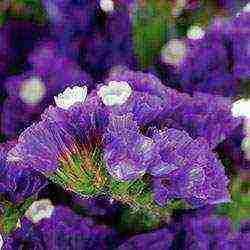 Statice is one of those plants that are able to captivate at first sight any gardener, even the most sophisticated. And this is not surprising, because this plant is not only unpretentious, but also blooms simply luxuriously, decorating even the smallest and most modest garden with its appearance. Today you will learn about the best varieties of the plant, as well as the features of growing and caring for it in the open field (photos and instructions are attached).
Statice is one of those plants that are able to captivate at first sight any gardener, even the most sophisticated. And this is not surprising, because this plant is not only unpretentious, but also blooms simply luxuriously, decorating even the smallest and most modest garden with its appearance. Today you will learn about the best varieties of the plant, as well as the features of growing and caring for it in the open field (photos and instructions are attached).
Statice: description of the main varieties and varieties
Statice is a well-known immortelle. Some people know this plant under other names - "limonium" or "kermek". Statice is an annual, but in most cases it is a perennial shrub or small shrub, reaching about 1.5 m.
Its leaves are straight, strongly elongated, most often basal, rather large, collected in a beautiful rosette. The stems of the plant are straight, practically devoid of leaves at the top, densely pubescent.
The bloom is spike-shaped, while the flower cups are filled with petals of white, yellow and a large number of blue, purple, pink shades. The flowers of the plant are most often colored in several different shades. Flowering peaks in mid-summer.
Attention! Although some gardeners recommend growing the statice as an annual plant due to its low frost resistance, experienced gardeners recommend trying to grow the plant as a perennial at least once, since this process is rather painstaking and laborious.
Statice surprises with its variety of varieties, among which everyone will find something to their liking:
- Statice notched. The variety is represented by a medium-sized shrub: it usually reaches a height of 0.5-0.6 m. The flowers are very small (no more than 1 cm in diameter), painted in a bluish-purple, white or pink hue.

Statice notched
- Chinese kermek. The variety was bred relatively recently.Due to its characteristics, it is grown in the middle lane mainly as an annual. The shrub is quite large: it can reach a height of about 0.7 cm. The external distinguishing feature of the plant is small, as if woven from lace, snow-white / cream flowers.
- Kermek Bondwelli. Tall variety, reaching 1.5 m in height. Grown as a perennial. Inflorescences are represented by loose clusters of white / yellow shades.
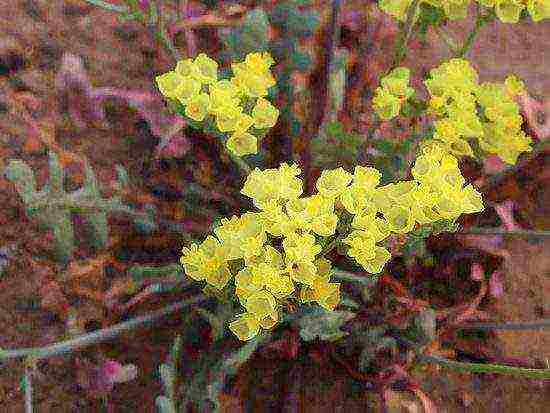
Kermek Bondwelli
- The statice is broad-leaved. A spherical plant, covered with many long, wide leaves and small purple flowers.
- Statice of Gmelin. An unpretentious perennial with an average height: it rarely reaches 0.5 m in height. It is considered one of the most cold-resistant varieties. Bluish-purple flowers are collected in fairly large shield-like inflorescences.

Statice Gmelin
Plant propagation
It doesn't matter if you plan to grow statice at home or outdoors: high-quality and generous seedlings can only be achieved by seed. Experts do not recommend plant propagation by vegetative methods, since the root system of the statice is so sensitive that it may simply not tolerate transplants.
You can get plant seeds in almost any specialty store, but not everyone can germinate them with high quality. The breeding process is quite laborious and complicated, but if you follow some rules, you will certainly be able to carry it out.
So, the first step is to carefully prepare the seed for planting. Since the seeds are long ribbed shells, it is not recommended to peel them off. But if this is not done, the material will germinate extremely slowly. In this case, there is a little trick: just lightly walk on the seed surface with sandpaper and then soak it in a wet mixture of sawdust and epin.
The seeds are planted immediately in separate containers (this is necessary in order not to damage the delicate root system of the plant in the future). For these purposes, standard peat pots are quite suitable.
For planting seeds, a special ready-made mixture is used, which it is also advisable to prepare in advance:
- Add some sand to the soil.
- Thoroughly sift the soil medium to remove small debris, including twigs, pebbles, etc.
- Preheat in the oven for a couple of hours at a temperature of about 100 degrees.
- Water the soil with weak potassium permanganate to protect future plants from pests and diseases.
- Moisten the soil slightly with warm water.
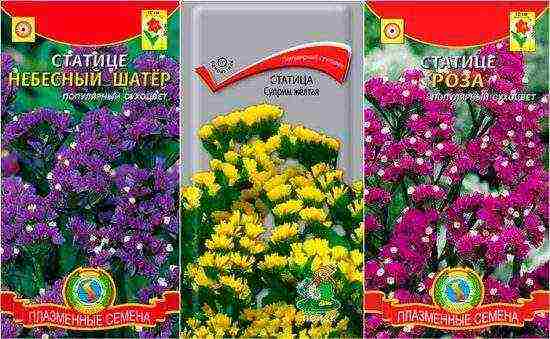
Statice seeds
The prepared seeds are laid out on the ground (this process is carried out approximately at the beginning of spring), laid out previously in separate containers, and lightly sprinkled with soil. Then be sure to cover the containers with glass or plastic and leave for 10-16 days in a bright, cool place (at a temperature of about 20 degrees). After this time, the first shoots should appear.
Advice. In order for the plant to reproduce successfully, do not forget to raise the "caps" and let in fresh air every day, and also check the degree of soil moisture.
As soon as the sprouts take root in the pots, the plants can be planted outdoors. Usually this process is carried out already in late spring, when the last winter frosts recede (if the region is cold enough, it is better to plant in early summer).
Planting plants in open ground
As you already know, shade is a risk factor for statice, so the planting site should be extremely sunny and warm. Do not be afraid to cultivate in a windy area, because the statice is not afraid of drafts and winds. Any soil is suitable for the plant, but if possible, it is better to plant in light sandstone / loam with a neutral / slightly alkaline environment.
The seedlings of statice should be handled extremely carefully, and the holes should be prepared for planting the same size as the peat pots, so that the entire earthen lump is placed in the holes. After planting the plants in the holes, be sure to pour them with brackish water (1 tablespoon of salt per 10 liters of water).
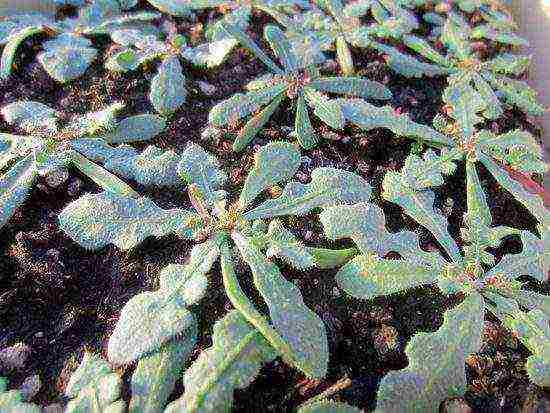
Seedling statice
Features of caring for a statice
The statice, as you know, is a very unpretentious plant, therefore it can successfully grow in the garden with practically no human participation in this process. But, since we are not talking about wild culture, there should be some care for the statice.
Watering and feeding mode
Remember that a flower practically does not need moisture when growing, so watering should be extremely rare. So, in the summer, when it is hot, it is enough to water the statice once every 1.5 months.
Watering should be carried out at the root, always with settled warm water (preferably in the evening). One of the waterings for the whole season must be necessarily salted water (about 6 tablespoons of salt per bucket of water). Do not forget to periodically loosen the soil around the plants.
Top dressing is something that the statice does not really need, but if the soil in your garden is not nutritious, it is better to make sure that the plant receives a sufficient amount of minerals. For the first time, mineral fertilizer is applied to the soil 7-10 days after planting seedlings. After that, the frequency of fertilization will depend on the value of the soil (once every 2-5 weeks). With the onset of autumn, feeding stops. If the soil is very fertile, the plant will not need fertilizer at all.
Disease and pest control
The plant rarely gets sick. Gardeners note that statice is one of the strongest plants in terms of resistance to pests and diseases. Its damage occurs in extremely rare cases, and with proper care, the word "disease" can be forgotten altogether.
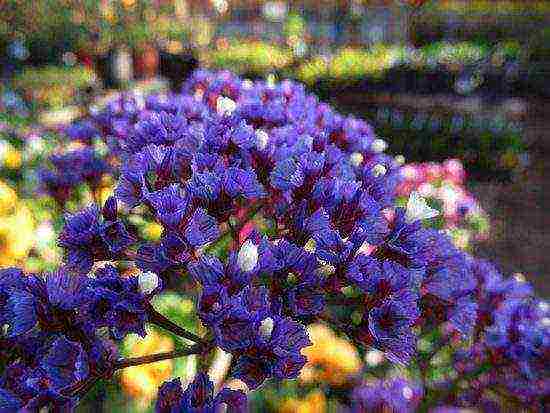
Most often, the statice gets sick from excess moisture.
But in some cases, a nuisance may occur: the statice will get sick with Botrytis. In this case, the disease can be triggered by excessively abundant watering or rainy summer. Any fungicide will help in the fight against the disease. In some cases, the plant is damaged by powdery mildew. To eliminate the disease, it is enough to spray the statice several times with a preparation containing sulfur.
Combination with other plants in the garden
The statice can be a great decoration for any garden with proper care. For decades, European landscape designers have been using this plant as the main decorative element in group flower arrangements.
So, the statice is perfect for decorating a bright mixborder, decorating a garden border, a rock garden. By the way, statice can become a wonderful "solo" in any garden: you just need to allocate a separate corner for the plant and enjoy a luxurious bright floral carpet as a result.

Statice goes well with most horticultural crops
It is worth noting that winter-hardy varieties of Kermek winter well in the open field. It is enough only at the end of autumn to cut the stems to ground level, cover them with cinquefoil or straw and cover them with a protective waterproof material. The plant will survive the winter perfectly.
That's all the subtleties you need to know in order to successfully grow statice in your garden. Good luck!
Landing statice: video
Many gardeners are interested in planting and caring in the open field for the article. This is a very beautiful dried flower, also known as the immortelle. It is also called limonium and kermek. Perennial and annual specimens are known.
On the territory of Russia and many European countries, it is quite difficult to grow perennial statice, since under the influence of the continental and cold climate they turn into annuals. They cannot withstand the winter cold, even if they provide shelter or wrapping with special material.There is an experience of digging bushes in the winter. These shrubs are kept indoors until warm. Typically, the bushes lack warmth and light.
The plant has rather high peduncles. Flowers of different shades are collected in lush, as well as openwork inflorescences in their shape resembling candles. Thanks to the wide range of colors, the immortelle can be perfectly combined with almost all types of flowers in the process of creating flower arrangements.
Many gardeners are interested in planting and caring in the open field for the article. This is a very beautiful dried flower, also known as the immortelle. It is also called limonium and kermek. Perennial and annual specimens are known.
On the territory of Russia and many European countries, it is quite difficult to grow perennial statice, since under the influence of the continental and cold climate they turn into annuals. They cannot withstand the winter cold, even if they provide shelter or wrapping with special material. There is an experience of digging bushes in the winter. These shrubs are kept indoors until warm. Typically, the bushes lack warmth and light.
Clairvoyant Baba Nina named the signs of the zodiac, on which money will fall from the sky in May 2018 ...
►
The plant has rather high peduncles. Flowers of different shades are collected in lush, as well as openwork inflorescences in their shape resembling candles. Thanks to the wide range of colors, the immortelle can be perfectly combined with almost all types of flowers in the process of creating flower arrangements.
The right time and soil
Statice is considered one of the easiest flowers to grow and reproduce. When choosing a statice, growing from seeds is not very difficult, but still there are some recommendations that are best taken into account. The sowing time of the seeds is determined depending on whether the germination will take place: in flower pots or in a greenhouse. With pot germination, planting should be started in the second half of February, and in a greenhouse - in March-April. Regardless of the method of germinating seeds, you need to adhere to a temperature in the range of 15-22 ° C.
Flower seeds should be planted on loose soil. It can be a peat substrate. You can purchase a special soil for growing seedlings. The main thing to remember is that the soil must have a loose structure. To increase the level of looseness, you need to add some sand to the soil. The soil should be carefully sieved with a large sieve to remove possible debris, twigs, and so on. After that, you should take a baking sheet of a suitable size and warm up the soil, after adding a weak solution of potassium permanganate to it. This procedure will destroy all fungal organisms. The finished substrate is scattered over flowerpots, where there is a drainage layer at the bottom. Before planting the flowers themselves, you should first slightly moisten the soil.
Seed preparation and sowing
Statice seeds are slightly oblong in shape, small in size and pointed at the ends. Due to the fact that the seeds are in a special shell, before planting, they must be poured with warm water. This will make the shell softer.
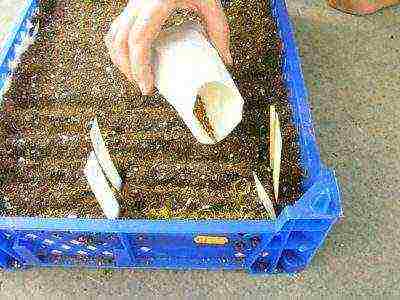
It is important to note that flowers are not very fond of transplanting. Therefore, the most correct thing is not to sow seeds in one container. It is better to sow one seed in each pot, since in the future the seedlings will develop, and its root system will become very voluminous.
The seeding process is very simple. Seeds are laid out on the surface of the prepared soil, and then they must be sprinkled on top with a small layer of soil. The containers should be placed in a greenhouse, or you can simply pull the film on top. Landing is easy. The main thing is to try to provide high-quality soil and warmth. Thus, the seedlings will sprout as quickly as possible. The first shoots may appear within 10 days.If you do not provide comfortable growing conditions, the emergence of seedlings can be expected up to 20 days.
In addition, experienced gardeners know additional tricks to help germinate seeds with a high germination rate quickly. Seedlings will quickly appear if you lightly rub the seeds with sandpaper in the area of the points, and then soak them in a special stimulating solution. You can take sawdust, moisten it and place the seeds there for several days. To speed up the process will help the daily heating of containers with planted seeds under a regular lamp for 4 hours. As soon as the seedlings sprout, do not postpone the picking process. There is no need to wait for the formation of two pairs of full leaves. The pick should be started immediately.
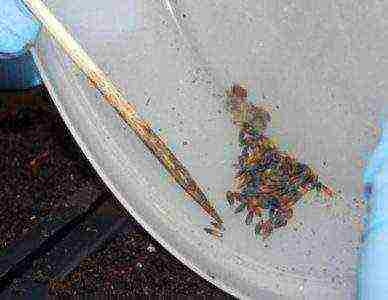
You can sow seeds outdoors. This is best done in April. Before that, you need to prepare the ground. To do this, remove all weeds from the soil, dig well, and then loosen the soil. After that, the surface is carefully leveled. Planting is carried out in grooves 2 cm deep. The distance between the seeds should be at least 15 cm. A sand mixture is poured on top. After that, you need to water the soil, trying not to erode the soil.
Limonium can also be propagated by cuttings rather than seeds. This is possible if there is already an adult plant from which the cutting can be separated.
Landing in open ground
The immortelle does an excellent job with bad weather conditions. Therefore, a month after the dive, it is necessary to land in open ground. It is better to do this after frost. The optimal time for disembarkation is June. There should be a distance of at least 30 cm between the seedlings, so that in the future the flowers do not interfere with each other. Otherwise, the active development of the root system will lead to its further interlacing with the roots of other plants. It is better to increase this distance than to decrease it. In addition, freedom will allow you to achieve high quality inflorescences. The flowering period should be expected 100 days after sowing the seeds. Statice are very fond of sunlight, so they can be planted with confidence in a sunny place. At the same time, the place where the plant will be grown must be protected from drafts and strong winds.
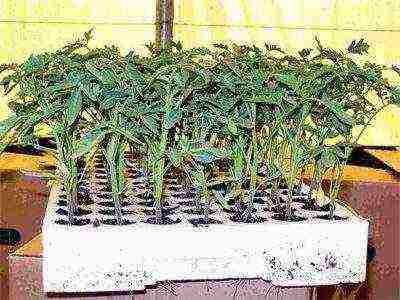
Seedlings are removed from the container or greenhouse as carefully as possible. When planting seedlings, you need to ensure that the root system is located in the hole as freely as possible. The holes should be about 15 cm deep. It all depends on the level of development of the root system. In the place where the statice flower is planted, there should be a little loose and nutritious soil. If you believe the theory, then it is permissible to grow a plant in a sandy type of soil, but full growth is possible thanks to the correct fertilization. Heavy soils with high moisture levels are categorically unsuitable.
Caring for flowers on the site
Despite their unpretentiousness, statice flowers require some care in open ground. Care implies the correct watering regime and timely feeding.
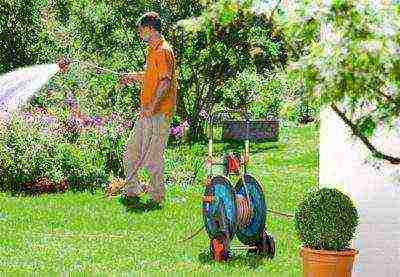
It is no secret that the immortelle is a drought-resistant plant growing in the steppe. This means that you should not overly moisturize the soil in the place where the flower grows. It is necessary to water the plant no more than once every 7 days. In the process of watering, a small amount of water is used - 300 ml per root.
It should be noted that watering is carried out during persistent heat and in the absence of regular rains. If the opposite situation is observed, then you should not use this irrigation scheme. Here, you should regularly loosen the top layer of the earth to ensure the flow of air to the root system. Water for irrigation needs to be slightly salted.
Top dressing of the soil should be carried out before the plant itself is planted. In this situation, complex fertilizer is used. This is more true for rich soils.If there are practically no nutrients in the soil, then the procedure is carried out every 15 days with organic fertilizers.
Experienced gardeners recommend dividing the feeding period into several stages. The first stage is the introduction of organic fertilizers into the soil. The second is organic and mineral substances. The third stage is flowering - fertilization with complex mineral fertilizers.
Cutting and drying the immortelle
Many gardeners, admiring the beauty of flowers, strive to keep them in this form for as long as possible. To do this, you need to have certain knowledge. You need to know how to properly cut and dry flowers. Initially, you need to cut the statics. It is best to perform the procedure during a dry time of the day. If you make a cut in wet weather, then most likely the plant will lose color, begin to darken and rot. For cutting, only those plants are suitable that have managed to bloom well, and the maximum number of inflorescences has opened on them. Plants should be hung to dry one at a time. At the same time, they are suspended with inflorescences down. Dry in a dry, dark place.
Many growers consider such a flower as statice to be a unique plant. After all, he is able to please the human eye with his bright and colorful appearance throughout all 12 months: first when flowering in the open field, and then in a dried form in colorful compositions.
And a little about secrets ...
The story of one of our readers Irina Volodina:
I was especially depressed by the eyes, surrounded by large wrinkles plus dark circles and swelling. How to remove wrinkles and bags under the eyes completely? How to deal with swelling and redness? But nothing makes a person look older or younger than his eyes.
But how to rejuvenate them? Plastic surgery? Recognized - not less than 5 thousand dollars. Hardware procedures - photorejuvenation, gas-liquid pilling, radiolifting, laser facelift? Slightly more affordable - the course costs 1.5-2 thousand dollars. And when to find all this time? And it's still expensive. Especially now. Therefore, for myself, I chose a different way ...
Read the article >>

